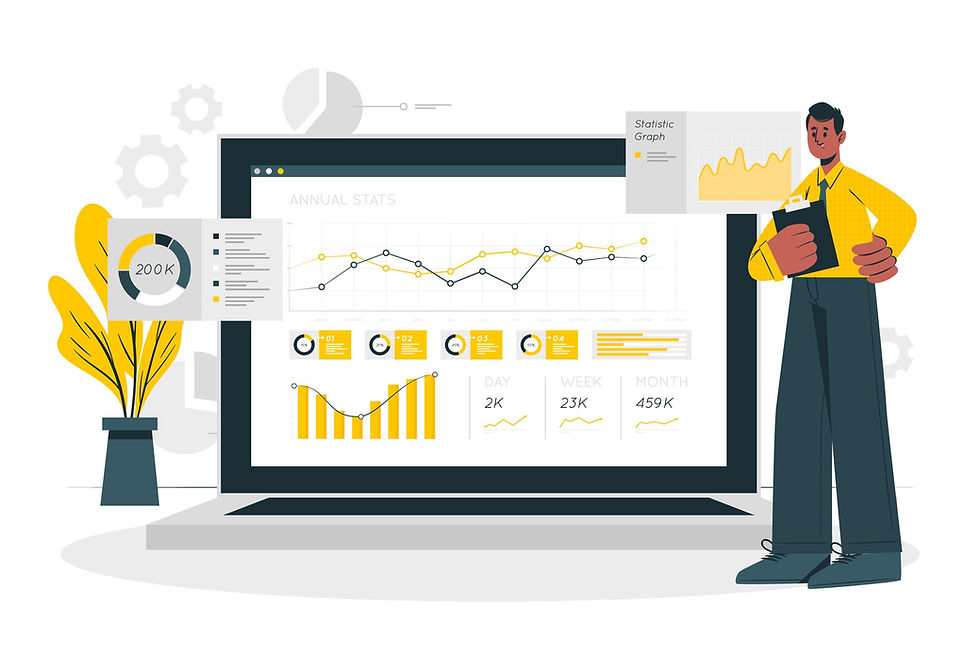Financial optimization has become an absolute priority in today's competitive business environment. According to Deloitte Insights, "Improving how we use data and analytics is one of the main concerns for financial leaders, as it enables more precise and efficient management of corporate resources" (Digital acceleration and strategy | Deloitte Insights). In this context, Power BI emerges as an essential tool for businesses, enabling a leap toward business analytics by transforming data into valuable information for better control, organization, and decision-making. It is possible to group budgets, financial KPIs (key performance indicators), sales, and other available data to manage your company optimally.

What is Power BI?
Power BI is a data analysis tool developed by Microsoft designed to help businesses extract more insights from the vast amounts of data they handle daily. It allows critical and essential business data, incorporating advanced functionalities that facilitate data management, visualization, and real-time control. Additionally, it is free for all Office 365 users, contributing to its growing popularity. In fact, in 2023, Power BI was positioned as a leader in the data analysis and business intelligence market by the 2023 Gartner Magic Quadrant for Analytics and BI Platforms, standing out for its accessibility and advanced capabilities (Microsoft named a Leader in the 2023 Gartner® Magic Quadrant™ for Analytics and BI Platforms | Microsoft Power BI-Blog | Microsoft Power BI).
Benefits of Power BI in Corporate Finances
Why has this tool become so popular for businesses and corporate finances? Here, we explore some of its main benefits:
Data Centralization: One of Power BI's most significant benefits is its ability to consolidate data from multiple sources in one place. Companies often handle dispersed data across SQL servers and various platforms, from ERP and CRM systems to spreadsheets and cloud services. Power BI integrates all this information through data modeling, giving users a unified and coherent view of their financial data. This centralization facilitates analysis, reduces the risk of errors, and improves operational efficiency by manually eliminating the need to gather data from different sources.
Real-Time Analysis: The ability to perform real-time analysis is crucial for effective financial decision-making. Power BI allows companies to continuously monitor their metrics, automatically updating dashboards with the most recent information. This means managers can quickly react to market changes, identify problems before escalating, and seize emerging opportunities. Real-time analysis provides a significant competitive advantage by enabling informed decisions based on up-to-date data.
Data Visualization: Power BI stands out for its intuitive visualization capabilities, helping users better understand financial metrics. Using charts, maps, and other visualizations, complex data is transformed into visually appealing and easy-to-interpret information. These visualizations not only make data more accessible to all members of the organization but also facilitate the identification of trends, patterns, and anomalies that might not be evident in traditional spreadsheets.
Mobile Access: Another critical advantage of Power BI is accessing reports and dashboards from any device. In today's business environment, employees need to stay constantly connected and have access to critical information, whether from the office, home or on the go. Power BI offers mobile applications that allow users to view and interact with their data in real-time from their smartphones or tablets. This mobile access ensures decision-makers have the information they need, enhancing the company's agility and responsiveness.
In our experience as financial analysts and external consultants for various companies, we have identified that these features resolve most operational problems and give companies a competitive edge. Introducing Power BI becomes a fundamental piece upon which strategies are built, objectives are controlled, and company goals are managed in the short, medium, and long term.
Case Study
To illustrate how Power BI can be integrated and generate value in an organization, consider a practical case. Our consultancy client had monthly sales targets to meet the budget established at the beginning of the year. A Power BI system was built that included sales information from their CRM, customer database data, monthly targets, the company's annual budget, and collection area information to control sales and collections. Thus, managers could review daily sales and develop sales strategies if the budget was far from being met or collection strategies if the company had liquidity problems.
The benefits within the company were numerous, and all the features of Power BI were essential to improving its operation and management. For example, using comparative charts with historical information made it easier for people with a low financial profile to understand the current situation and the strategy to follow. Thanks to mobile access, there did not impede managers from having the best information at hand. On one occasion, the manager developed a collection policy targeted at customers who took the longest to pay to solve liquidity problems while on vacation in another country, all through his phone.

Conclusion
I hope you have fewer doubts about using Power BI within your company. This tool allows for time optimization by not having to organize all the information every time a decision needs to be made, as well as keeping information constantly updated. Power BI facilitates operational optimization by leveraging the company's most essential data in a large data pool for its benefit. Finally, it enables resource optimization by monitoring goals, strategies, and objectives, making critical decisions that ensure greater profitability, and it is a free tool that provides a quality leap for managing your business.
If you have not yet implemented Power BI in your company, now is the time to do so. Contact us for a consultation and discover how this tool can transform financial management.
Comments